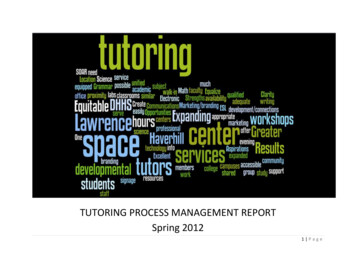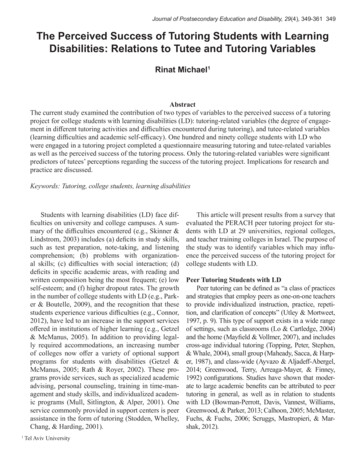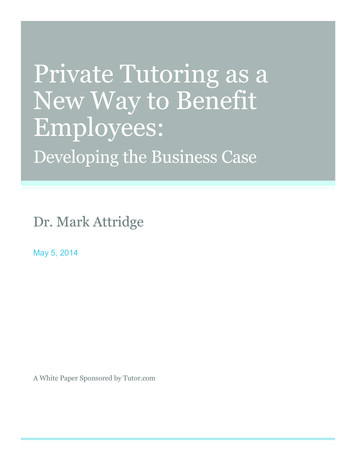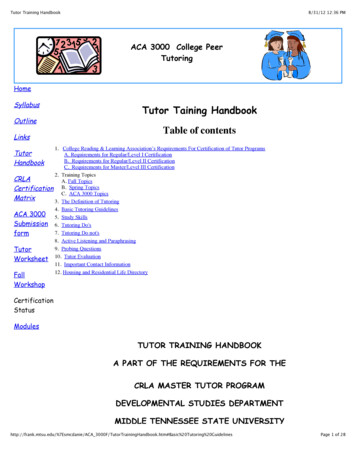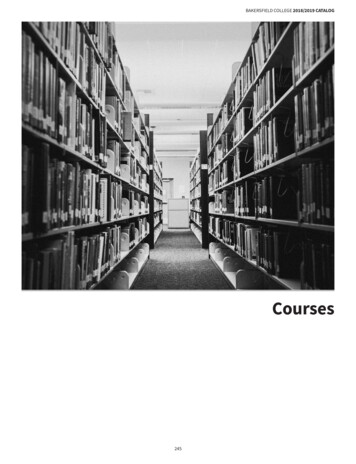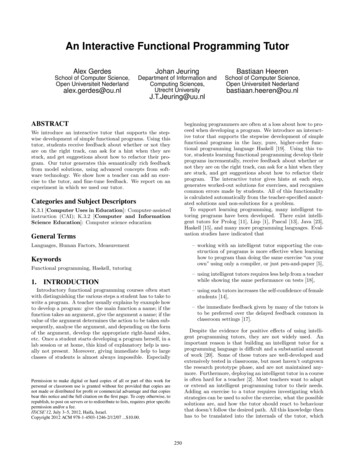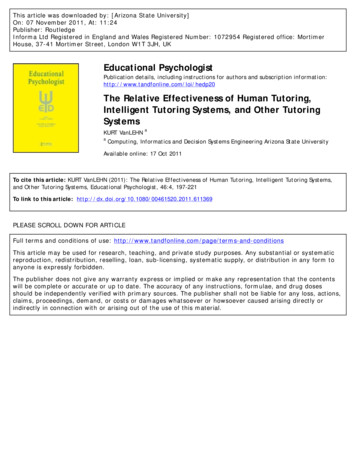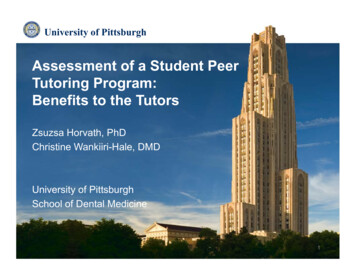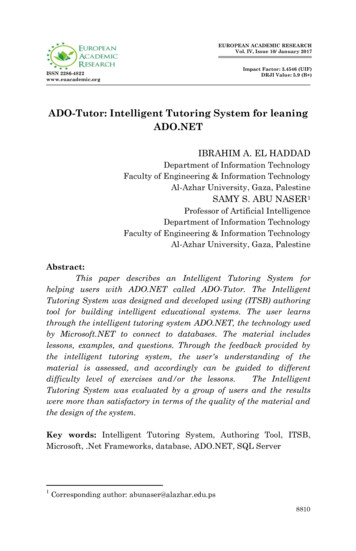
Transcription
EUROPEAN ACADEMIC RESEARCHVol. IV, Issue 10/ January 2017Impact Factor: 3.4546 (UIF)DRJI Value: 5.9 (B )ISSN 2286-4822www.euacademic.orgADO-Tutor: Intelligent Tutoring System for leaningADO.NETIBRAHIM A. EL HADDADDepartment of Information TechnologyFaculty of Engineering & Information TechnologyAl-Azhar University, Gaza, PalestineSAMY S. ABU NASER1Professor of Artificial IntelligenceDepartment of Information TechnologyFaculty of Engineering & Information TechnologyAl-Azhar University, Gaza, PalestineAbstract:This paper describes an Intelligent Tutoring System forhelping users with ADO.NET called ADO-Tutor. The IntelligentTutoring System was designed and developed using (ITSB) authoringtool for building intelligent educational systems. The user learnsthrough the intelligent tutoring system ADO.NET, the technology usedby Microsoft.NET to connect to databases. The material includeslessons, examples, and questions. Through the feedback provided bythe intelligent tutoring system, the user's understanding of thematerial is assessed, and accordingly can be guided to differentdifficulty level of exercises and/or the lessons.The IntelligentTutoring System was evaluated by a group of users and the resultswere more than satisfactory in terms of the quality of the material andthe design of the system.Key words: Intelligent Tutoring System, Authoring Tool, ITSB,Microsoft, .Net Frameworks, database, ADO.NET, SQL Server1Corresponding author: abunaser@alazhar.edu.ps8810
Ibrahim A. El Haddad, Samy S. Abu Naser- ADO-Tutor: Intelligent TutoringSystem for leaning ADO.NETINTRODUCTIONThe beginning of ASP back in late 1996 when ADO 1.0 wasreleased representing a new way of dynamically reclaimingdata from a database. Though ADO was at its early childhoodthen, and was something of an offshoot of DAO and RDO,nonetheless it represented a new bold direction. Eachsubsequent version of the technology takes us one step closer toADO 2.6, when development finally came out. At this point,evolving from the shadows came out the most radicalframework to date – .NET, with it the very powerful andcomplete ADO.NET [1,2].This new data module, presented with .NET, offered anexciting new method to data access. However the methods, andlogic used to connect to databases with ADO.NET weren’tshockingly different from those used with its ancestor,ADO.NET had a lot to bargain. What was sole about thistechnology was the construction underneath it all, its powerfulmethodology to data organization, and the elasticity in the nextlevel of data-presenting devices [3].ADO, for its time, was definitely successful. Even thoughthe re-releases of the technology had not indicated intensechange for ADO, it attained what it had to within its ownconstruction. Though, it was repeatedly overwhelmed byproblems that fenced its management of disengaged datastores, and functioning appropriately and tersely with XML.This is where ADO.NET came in – these are the two things thenew technology simply succeeds, as XML is the essentialconstituent of the whole .NET Framework! ADO.NET wassimply produced to solve all the lacks found in ADO, and offersdevelopers with the power to attain more with less [4-6].ADO-Tutor was designed and developed using ITSBauthoring tool [23].EUROPEAN ACADEMIC RESEARCH - Vol. IV, Issue 10 / January 20178811
Ibrahim A. El Haddad, Samy S. Abu Naser- ADO-Tutor: Intelligent TutoringSystem for leaning ADO.NETThe goal of our intelligent tutoring system was to help userslearn easily how to use ADO.NET and to connect to databases.The benefits of Intelligent Tutoring Systems include[7]: ITS are available at any time of the day, even late atnight before an exam. ITS provide real-time data to teachers and developerslooking to enhance their teaching methods. ITS reduce the dependency on human resources ITS help students more in understand material bypermitting them to first state what they know, then byoutfitting responses accordingly ITS afford educators the chance to produceindividualized programs due to their tailored nature. ITS harvest higher exam marks than traditionalsystems, particularly in students from special education,non-native English, and low-income backgrounds. ITS Provide immediate customized feedback, individualtask selection, on-demand hints, and provision formastery learning.Some of the criticism of Intelligent Tutoring Systems includes: ITS is difficult to measure its effectiveness ITS immediate feedback and hint sequences fail toimprove deep learning in students. ITS fail to ask questions of students that may clarifytheir actions. ITS implementation may be hard to defend to anadministrative staff. ITS evaluation often hard, costly and time consuming. Human tutors are currently better than ITS in providingproper dialogue and feedback. Human tutors are currently better than ITS ininterpreting and adapting to different emotional states.EUROPEAN ACADEMIC RESEARCH - Vol. IV, Issue 10 / January 20178812
Ibrahim A. El Haddad, Samy S. Abu Naser- ADO-Tutor: Intelligent TutoringSystem for leaning ADO.NETLITERATURE REVIEWAn Intelligent tutoring system provides customized feedbackinstruction to students [23,33]. There are many ITS systemdesigned for educational purposes [8-15,25], an agent based ITSfor Parameter Passing in Java Programming[17], JavaExpression Evaluation [13], Linear Programming[10,31], anIntelligent Tutoring System for Entity RelationshipModeling[16], an Knowledge-based Intelligent Tutoring Systemfor Teaching Mongo Database[22], ITS for learning SoftwarePatterns [7], Design and Development of an IntelligentTutoring System for C# Language[32], ITS called JO-Tutor forhelping students to learn Java Programming language [28], ITSwhich called CPP-Tutor for helping student to learn C Programming Language[14], a comparative study betweenAnimated Intelligent Tutoring Systems (AITS) and Video-basedIntelligent Tutoring Systems (VITS) [24], effectiveness of elearning[26], computer aided instruction[9], effectiveness of theCPP-Tutor[29], teaching AI searching algorithms[15], teachingdatabase to sophomore students in Gaza[12], and Predictinglearners performance using NT and ITS [8], design anddevelopment of diabetes ITS[30 ], ITS teaching grammarEnglish tenses [27], ITS for teaching advanced topics ininformation security[19], development and evaluation of theOracle Intelligent Tutoring System (OITS)[20], ITS for learningComputer Theory[21], e-learning system[11,18,27].ITS ARCHITECTUREFigure 1: Architecture of ADO-TutorEUROPEAN ACADEMIC RESEARCH - Vol. IV, Issue 10 / January 20178813
Ibrahim A. El Haddad, Samy S. Abu Naser- ADO-Tutor: Intelligent TutoringSystem for leaning ADO.NETModern intelligent tutoring system architectures consist of fourmodules as in Figure 1. The four modules are representednormally as the domain module, student module, tutoringmodule and the interface module[7,12].The domain module is how the material is representedand stored to be ready for transmitting to the learner.The domain module is connected to the student moduleand the tutoring module. The student module represents thelearner’s conduct such as his learning style, motivation level,his interests, and profile. All the student conduct is logged intothe system and used for reasoning and adapting the domainmodule to the learner’s needs [15].The tutoring module acts as a computer-generatedinstructor, presenting the material in an proper order,according to the student learning style and his skills. This is acollaborating process and this module has the task to clarify theconcepts to the learner given few points of view and supportiveall the learning procedure [19].With the capacity to interconnect and cooperate with thestudent, the interface module has an enormously significantjob. If one ITS have great tutoring, student and domainmodules, but the interface module is very deprived, the ITS willnot be operative because the interface is the front of wholesystem and has the aptitude to capture all the care of thelearner [21].DOMAIN MODEL ARCHITECTUREThe domain model of ADO-Tutor includes the followingmaterial: Lesson 01: Introduction to ADO.NET Lesson 02: The SqlConnection Object Lesson 03: The SqlCommand Object Lesson 04: Reading Data with the SqlDataReaderEUROPEAN ACADEMIC RESEARCH - Vol. IV, Issue 10 / January 20178814
Ibrahim A. El Haddad, Samy S. Abu Naser- ADO-Tutor: Intelligent TutoringSystem for leaning ADO.NET Lesson 05: Working with Disconnected Data – TheDataSet and SqlDataAdapterLesson 06: Adding Parameters to CommandsLesson 07: Using Stored ProceduresSTUDENT MODEL ARCHITECTUREThe system sore the student data in a database, and byrecording his own name, number, last session time and date,lesson learned, current score, overall core and all the details ofthe student or the learner of the system.TEACHER MODULE ARCHITECTUREThe storage information about the user can used to customizethe feedback to display the relevant information to studentsabout the educational level and stage passed the student andhow much he/she studied, and difficulty level reached. Forexample, when the student's current score out of 100 reaches 75or more, the tutoring module takes the student to next level ofdifficulty and give the student a notification about the scorehe/she achieved.USER INTERFACE MODELThe tool used for building the ADO-Tutor has two interfaces inone. The first is the teacher interface, where he/she can addthe lessons, questions, answers, level of difficulties, basic ITSdata, Basic student data, and customize the coloring of thescreen of the system. The second interface is the studentinterface where he/she is allowed to the leering material screen,questions screen, statistics about his performance screen asseen Fig 2-Fig5.EUROPEAN ACADEMIC RESEARCH - Vol. IV, Issue 10 / January 20178815
Ibrahim A. El Haddad, Samy S. Abu Naser- ADO-Tutor: Intelligent TutoringSystem for leaning ADO.NETFigure 2: In this interface student chooses the desired lesson to learnFigure 3: In this interface student chooses examples required to takeadvantageFigure 4: In this interface student chooses question to try and answer it.EUROPEAN ACADEMIC RESEARCH - Vol. IV, Issue 10 / January 20178816
Ibrahim A. El Haddad, Samy S. Abu Naser- ADO-Tutor: Intelligent TutoringSystem for leaning ADO.NETFigure 5: This is a special notification about the progress of thestudentEVALUATIONDO-Tutor was presented to a group of specialists in the field toevaluate it and gives us feedback about the design of thesystem, the material offered to the learners, easiness of use,quality and expressiveness of the exercises and their relation tothe lessons given to the learners. The results of the evaluationwere promising. We will do some more evaluation in the nearfuture to check the effectiveness of the ADO-Tutor and takeinto considerations the comments of the evaluators.CONCLUSIONIn this paper, we created an intelligent tutoring system calledADO-Tutor for teaching database connection. ADO-Tutor wasdesigned and built using ITSB authoring tool. Through whathas been reviewed we have created a simple and easy way toexplain the material instruction, while ensuring that thestudent take advantage of through questions and find solutionsfor those who could not answer. An initial evaluation was doneby a set of specialist in the field and the results were promising.In the future, we will increase the lessons to cover a greaterrange of educational material.EUROPEAN ACADEMIC RESEARCH - Vol. IV, Issue 10 / January 20178817
Ibrahim A. El Haddad, Samy S. Abu Naser- ADO-Tutor: Intelligent TutoringSystem for leaning ADO.NET Code Examples - MSDN - MicrosoftDatabase Programming - ADO.NETDatabase Programming using ADO.NET and C#Introduction to ADO.NET - SitePointCreate a Database with ADO.NET - XamarinJeremić, Z. (2005). An Intelligent Tutoring System forlearning Software Patterns (in Serbian), Master Thesis,Belgrade, Serbia.8. Naser, S. S. A. (2012). Predicting learners performanceusing artificial neural networks in linear programmingintelligent tutoring system, International Journal ofArtificial Intelligence & Applications, Academy & IndustryResearch Collaboration Center (AIRCC), 3,2, 65-73.9. Naser, S.S A., & Sulisel, O. (2000). The effect of usingcomputer aided instruction on performance of 10th gradebiology in Gaza.10. Naser, S. A., Ahmed, A., Al-Masri, N., & Abu Sultan, Y.(2011). Human Computer Interaction Design of the LP-ITS:Linear Programming Intelligent Tutoring Systems,International Journal of Artificial Intelligence &Applications (IJAIA), 2(3),60-70.11. Chrstan Wolf, "I-Weaver: Towards learning style-base elearning in computer science education", proceedings of theAustralian Computing Education Conference, 2003.12. Naser, S. S. A. (2006). Intelligent tutoring system forteaching database to sophomore students in Gaza and itseffect on their performance, Information TechnologyJournal, Scialert,5(5),916-922.13. Abu Naser, S. (2008). JEE-Tutor: An Intelligent TutoringSystem for Java Expression Evaluation, InformationTechnology Journal, Scialert , 7(3),528-532.EUROPEAN ACADEMIC RESEARCH - Vol. IV, Issue 10 / January 20178818
Ibrahim A. El Haddad, Samy S. Abu Naser- ADO-Tutor: Intelligent TutoringSystem for leaning ADO.NET14. Naser, S.S. A. (2008). Developing an intelligent tutoringsystem for students learning to program in C ,Information Technology Journal, Scialert,7(7),1055-1060.15. Naser, S.S.A. (2008). Developing visualization tool forteaching AI searching algorithms, Information TechnologyJournal, Scialert,7(2), 350-355.16. Pramuditha Suraweera & Antonija Mitrovic. KERMIT, AnIntelligent Tutoring System for Entity RelationshipModeling. Private Bag 4800, Christchurch, New Zealand17. Naser, S. A. (2008). An Agent Based Intelligent TutoringSystem For Parameter Passing In Java Programming,Journal of Theoretical & Applied Information Technology,4,7.18. Mahmoud, A. Y., Barakat, M. S., & Ajjour, M. J. (2016).Design and Development Of ELearning University System.(Journal of Multidisciplinary Engineering Science Studies(JMESS), 2(Issue 5, May - 2016), 498-504.19. Mahdi, A. O., Alhabbash, M. I., & Abu Naser, S. S. (2016).An intelligent tutoring system for teaching advanced topicsin information security, WWJMRD, 2(12), 1-9.20. ALDahdooh, R., & Abu Naser, S.S. (2017). Development andEvaluation of the Oracle Intelligent Tutoring System(OITS), European Academic Research, 4(10).21. Al-Nakhal M.A., & Abu Naser, S. S. (2017). An IntelligentTutoring System for learning Computer Theory, EuropeanAcademic Research, 4(10).22. Hilles, M. M., & Abu Naser, S.S. (2017). Knowledge-basedIntelligent Tutoring System for Teaching Mongo Database,European Academic Research, 4(10).23. Abu Naser, S. S. (2016). ITSB: An Intelligent TutoringSystem Authoring Tool. Journal of Scientific andEngineering Research, 3(5), 63-71. 24. Abu Naser, S.S. (2001). A comparative study betweenAnimated Intelligent Tutoring Systems (AITS) and Video-EUROPEAN ACADEMIC RESEARCH - Vol. IV, Issue 10 / January 20178819
Ibrahim A. El Haddad, Samy S. Abu Naser- ADO-Tutor: Intelligent TutoringSystem for leaning ADO.NETbased Intelligent Tutoring Systems (VITS), Al-AqsaUniversity Journal,5,1 Part,1.25. C. J. Butz, S. Hua, R. B. Maguire, "A web-based Bayesianintelligent tutoring system for computer programming",Web Intelligence and Agent Systems, Vol.4, No.1, pp.77-97 ·January 2006.26. Abu-Naser, S., Al-Masri, A., Abu Sultan, Y., & Zaqout, I.(2011). A prototype decision support system for optimizingthe effectiveness of e-learning in educational institutions,International Journal of Data Mining & KnowledgeManagement Process (IJDKP),1, 1-13.27. Alhabbash, M. I., Mahdi, A. O., & Abu Naser, S.S. (2016).An Intelligent Tutoring System for Teaching GrammarEnglish Tenses, European Academic Research, 4(9).28. Abu-Naser, S., Ahmed, A., Al-Masri, N., Deeb, A.,Moshtaha, E., & AbuLamdy, M. (2011). An IntelligentTutoring System for Learning Java Objects, InternationalJournal of Artificial Intelligence and Applications (IJAIA),2(2).29. Naser, S. (2009). Evaluating the effectiveness of the CPPTutor an intelligent tutoring system for students learning toprogram in C , Journal of Applied Sciences Research, 5(1),109-114, http://www.aensiweb.com/JASR/.30. Almurshidi, S. H., & Abu Naser, S. S. (2016). Design andDevelopment of Diabetes Intelligent Tutoring System,European Academic Research, 4(9).31. Naser, S. S. A. (2012). A Qualitative Study of LP-ITS:Linear Programming Intelligent Tutoring System,International Journal of Computer Science & InformationTechnology, 4(1),209-220, Academy & Industry ResearchCollaboration Center (AIRCC)32. Al-Bastami, B.H., & Abu Naser, S.S. (2017). Design andDevelopment of an Intelligent Tutoring System for C#Language, European Academic Research, 4(10).EUROPEAN ACADEMIC RESEARCH - Vol. IV, Issue 10 / January 20178820
Ibrahim A. El Haddad, Samy S. Abu Naser- ADO-Tutor: Intelligent TutoringSystem for leaning ADO.NET33. Alnajjar, M., & Naser S.S.A. (2015). Improving Quality OfFeedback Mechanism In Un By Using Data MiningTechniques , International Journal of Soft Computing,Mathematics and Control, 4(2).34. Abu Naser, S. (1993). A methodology for expert systemstesting and debugging, North Dakota State University, USA1, 1-130.35. Naser, S.S.A. (1999). Big O Notation for Measuring ExpertSystems complexity, Islamic University Journal - Gaza 7(1), 77-57.EUROPEAN ACADEMIC RESEARCH - Vol. IV, Issue 10 / January 20178821
ITS implementation may be hard to defend to an administrative staff. ITS evaluation often hard, costly and time consuming. Human tutors are currently better than ITS in providing proper dialogue and feedback. Human tutors are currently better than ITS in interpreting and adapting to different emotional states.
